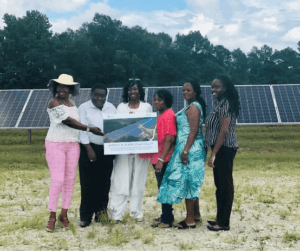Climate Solutions Benefit Children in Environmental Justice Communities
Almost ten years ago, I met Ms. Loretta Slater who had just lost her only daughter, Whitney, to breast cancer at the age of 21, after battling the disease for two years. Ms. Loretta often shares the story of how her daughter was raised in one of the countless environmental justice communities. She often talks about the conditions of the area in which Whitney was raised, and she believes that this contributed to her daughter’s illness and passing. Whitney was raised in Darlington, SC, where she lived across the street from an oil mill, and less than a quarter mile away from a sawmill. Whitney’s story is just one of many in which we see how the pollutants and toxins contributing to climate impacts also adversely affect the health of children living in environmental justice communities. As a result of their experiences, Whitney’s mom and grandmother formed The Whitney M. Slater Foundation after her passing to determine environmental and climate solutions in environmental justice communities.
What are Environmental Justice Communities?
Environmental justice (EJ) communities are those who have faced years of disinvestment and are overburdened by environmental pollution. EJ communities are disproportionately people of color, low-income, environmentally overburden, environmentally vulnerable, and tribal communities. A multitude of factors contribute to the environmental health disparities within these communities, and they are often hit the hardest by both climate impacts and air pollution, which are known to increase the risks of acquiring cardiovascular disease, cancer, respiratory problems, and other diseases at some point in life.
Implementing the Change.


In 2018, The Whitney M. Slater Foundation team cut the ribbon for the Duke Energy and Pinehurst solar farm (named after the Whitney M. Slater Foundation) serving 2,500 low-income rural households in the Pee Dee region of South Carolina.
In honor of Children’s Health Month (and throughout the year), we can focus on implementing a plan that will establish a better and healthier place for our children and future generations. Here are several recommended actionable steps that can lead to the implementation of community-led climate solutions.
- Community members can lead the planning, decision making, allocation of resources, implementation, and evaluation processes.
- Communities can identify the issues that are prevalent in their communities.
- Communities can identify the solutions to those problems.
- We can provide the support and resources that those communities need.
- We can ensure that resources are allocated in a way that creates a just transition, for communities with a legacy of poverty and pollution.
As community-led climate solutions are implemented successfully, we will hear fewer stories like Whitney’s in the future. Furthermore, we will see the health of children living in environmental justice communities improve, as they transition from just surviving to thriving.
Ayanna N. Woodberry, MS, MPH is a Climate for Health Ambassador and member of the American Public Health Association. Ms. Woodberry also serves as the Board Chair of the Whitney M. Slater Foundation.